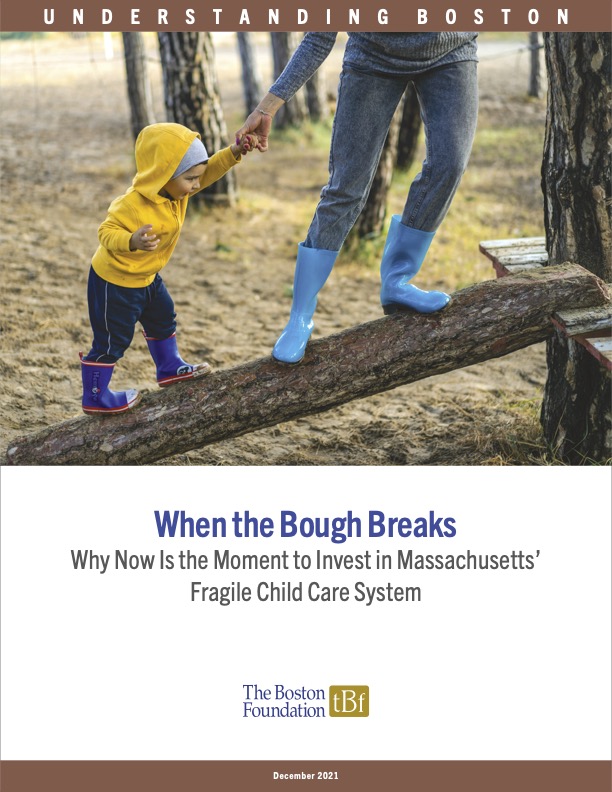
When the Bough Breaks
I. The Child Care Ecosystem in 2021
The early education and care system in Massachusetts is at a breaking point. The Commonwealth has the second most expensive child care market in the United States. Families routinely pay upwards of $20,000 a year for care for their young children.1 Paying for child care in the state is the equivalent of a second mortgage for some families and more than the cost of public college tuition for others.2 Even so, child care workers make very low wages and are leaving the workforce in droves because they can make more at jobs at the local hardware store or Dunkin’ Donuts.3 Child care providers are struggling to keep their businesses afloat amidst high costs and labor shortages.
The COVID-19 pandemic has made an already very challenging situation worse. The state was facing a large decline in programs in the decade before the pandemic, according to the Massachusetts Department of Early Learning and Care. Now, more facilities and classrooms across the state have closed their doors. Nationally, the industry is operating at only 88 percent of its pre-pandemic capacity but the situation is worse in the Commonwealth, where providers face some of the highest costs in the nation and strict quality and safety standards.4 One analysis showed Massachusetts had the weakest rebound in child care employment of any state in the nation.5 The number of openings, or ”seats,” for young children fell by as much as 20 percent in Massachusetts since the pandemic and it’s not clear if those seats will return.6
Boston, for example, experienced a 21 percent decrease in the number of licensed center-based and family child care providers since 2017.7 Those centers that remained open are making difficult decisions about reducing capacity—closing classrooms this fall because they could not find staff to fill empty positions.
AUTHOR
Sarah Jackson
EDITORS
Brianna A. Savage and Sandy Kendall, The Boston Foundation

“The directors I talk to are panicked,” says Amy O’Leary, who runs Strategies for Children, a statewide early childhood advocacy group. “They are in their classroom from morning until night because they can’t find enough staff.”
The reduction in capacity is intensifying just as many parents, working mothers particularly, are hoping to return to work outside of the home. Women, whose workforce participation is at its lowest level in decades due to the pandemic,8 now face long waiting lists for available child care spots.9 Janice Handrahan, District Manager of KinderCare Education, told Western Mass News this summer that many of their centers in the Springfield region were completely full with waitlists.
“There’s such a challenge right now finding care,” she said.10
Parents are weighing whether long commutes to work and child care—and the high costs of both—are worth the stress and the large percentage of paychecks consumed. Some families are making the decision not to have additional children, because they don’t see how they could afford even higher child care costs.11 Others are deciding that they cannot return to work because of the lack of available and affordable child care.12
The early education and care crisis is having a more severe impact on families of color who’ve been disproportionately impacted by the pandemic.
A greater share of Black, Latinx and immigrant families have gotten sick, lost loved ones and experienced job and housing loss than White families. These populations are more likely to be low-wage workers and more likely to be unable to afford high child care costs. They are also more likely to use informal or family child care providers who have suffered closures during the pandemic.
Experts like O’Leary say the system is on the verge of collapse. Massachusetts employers are reporting concerns about finding workers and about child care and school issues affecting their employees’ ability to be present, engaged, timely and productive. “When programs are not able to open, when child care centers close their doors, people are going to be mad,” O’Leary says. “And they are going to say, ‘Why didn’t anyone tell us that this was about to collapse?’”
This report examines key data on how COVID-19 has impacted the child care system in Massachusetts along with original reporting and interviews. We find that diverse sectors in the state agree now is the time for greater public investment to stabilize the early education and care system and ensure economic recovery for the Commonwealth.
II. The Power of Early Education and Care
We know from recent developments in neuroscience and molecular biology that the experiences children have in the first five years of life help build crucial foundations for their learning, behavior and health. According to research by Jack Shonkoff and his colleagues at the Harvard Center for the Developing Child, in the first few years of life, children’s brains form more than one million new neural connections every second.13 In these years, children’s brains are building the foundations they will need for skills like cognition, attentiveness, motivation and self-regulation.
And it turns out, researchers have discovered, that children’s environments in the early years of life contribute to the development of the structure and circuitry of their brains as they grow.14
Young Children in the Commonwealth
There are approximately 430,000 children aged 5 and under in Massachusetts, the vast majority of whom need care while their parents work.19 Fourteen percent of children 5 and under are living in poverty.20 Before the pandemic, 75 percent of children were living in households where all adults work full-time. Yet there is only room for a fraction of these children in the state’s current child care system.21 Forty-four percent of children in the state are children of color, and studies show they are more likely to have experienced educational disruptions and to have lost a family member to COVID-19.22
When young children receive high quality early education and care in stable settings, research from Shonkoff and others shows, it helps them build the strong foundation they will need for emotional development and learning. When children don’t have these important early experiences or miss out on responsive interactions with the adults in their lives, it threatens their development and well-being over the long term.15
High-profile studies like Perry Preschool in Ypsilanti, Michigan, the Child-Parent Centers in Chicago, and the Abecedarian program in North Carolina are renowned for showing that quality early education and care can help children succeed and overcome adversity such as poverty and early trauma.16
Research shows that when children attend high quality early childhood classrooms, with well supported teachers, they end up needing fewer support services later in life, all of which lead to reduced costs down the line to society.17 In fact, economist and Nobel Laureate James Heckman has estimated that the rate of return for investment in quality early childhood education is 13 percent per annum through better outcomes in education, health, sociability, economic productivity and reduced crime.18
Early care and education is expensive, but Heckman’s research shows the returns are enormous. In fact, returns are much higher than the rate of return over the last 60 years in the U.S. stock market, according to Heckman. Experts say investments in early childhood education tackle social inequality, help build the future workforce, reduce future costs to society in social programs and are some of the best investments a state can make in its future.
III. The Impact of the Care Crisis: Stories from the Commonwealth
Laura Perille
CEO, Nurtury, Inc.
Laura Perille runs Nurtury, one of the largest providers of early education and care in Boston. She told the Boston Globe this summer that she cannot find enough workers to maintain her classrooms.23 Child care workers in Massachusetts, most of whom are women of color, make a median wage of $14 an hour.24 Throughout New England these workers experience high rates of poverty and often lack any benefits.25 Early educators with a bachelor’s degree are paid 35 percent less than their colleagues in the K–8 system, essentially paying a penalty for working with younger children.26
“This is a staffing crisis,” Perille told the Globe. Without enough workers to fill classrooms, Perille made the difficult decision this year to close one of Nurtury’s five centers in Greater Boston, a move that advocates say is a statewide trend.
Finding child care workers is a crisis nationwide.27 But educators like Perille say the situation is worse in Massachusetts, which has an aging early education and care workforce. During the pandemic many of these older workers chose to retire. One analysis showed the state’s child care workforce was 41 percent smaller in the third quarter of 2020 than it was before the pandemic.28 The state’s high cost of living makes it nearly impossible to live on the low wages child care workers make. But raising wages to the level needed to attract new workers can be a challenge for providers to afford to do on their own—and passing a greater share of the cost on to end users would shut out even more families.
Massachusetts also has high standards for quality and for health and safety, which is right and good but adds to the cost burden of running child care centers.
Fixing the system, experts say, must begin with public investments in the early education and care workforce.
“If you have access to better pay and health insurance [in another job], we can’t fault people for not coming back to do this work,” Lea J. Austin, Executive Director of UC Berkeley’s Center for the Study of Child Care Employment, told the LA Times in September 2021. “We can’t get to good, stable child care if we can’t stabilize and support the early care and education workforce, and until we intervene with some public resources, we’re running in circles.”29
Maureen Peterson
Parent of a 3-year-old and 6-year-old
Several years back, Westfield mom Maureen Peterson made the difficult decision to leave her job because she realized it was costing more to keep her two young daughters in child care than she was earning.
“I realized I was effectively paying one dollar and 78 cents each day to work,” Peterson says. “It made no sense.”
At that time, child care for the two children cost almost $800 a week. Peterson had to go back to work after her husband was laid off and the family has juggled a variety of child care arrangements since then. Today, Peterson and her husband both work full-time and options for child care in Western Mass are limited. Most of the child care centers have waiting lists and only operate until 3:00 or 4:00 p.m.
During the pandemic, when her youngest daughter’s child care center closed, Peterson and her husband shared care duties while juggling working from home, with friends pinch-hitting. Her eldest attended kindergarten on Zoom. She’s not sure how they got through it. Today her eldest attends first grade in person at the local public elementary school and her three-year-old is enrolled in preschool at the local YMCA. Peterson and her husband trade off picking up the children in the mid-afternoon. When they have to return to the office in person, Peterson is not sure how they will afford it. “It’s going to cost us $600 a month more to pay for the before and after care,” she says.
Peterson just finished school but, as a graduate student, did not qualify for subsidies and couldn’t afford to take advantage of on-campus child care options. The family also can’t afford the child care center onsite at her husband’s employer. They think of themselves as a hardworking middle-class family. Yet, Peterson says, all the options available to them for child care were “prohibitively expensive.”
Louise Jeffy-Dennis
Parent of a 2-year-old and a 7-month-old
Louise Jeffy-Dennis lives in Sturbridge and works in Boston and the Metrowest area. She and her husband have a toddler and an infant, born during the pandemic.
Before COVID-19, the family was paying $600 a week for child care for her one son. Jeffy-Dennis is a psychologist. Her husband works for the state, and they make a good living—too much to be eligible for child care subsidies yet not enough to be able to afford the $600 a week easily. Jeffy-Dennis knew that families with two children face an even larger burden and that their child care expenses could more than double when adding a new baby. The Economic Policy Institute estimates that a typical family in Massachusetts would have to spend 39 percent of its income on child care for an infant and a 4-year-old, for example.30
Once their second child was born, Jeffy-Dennis pulled her older son out of the child care center he was in to save money. Since then, the family has struggled to find affordable, available options that are open during the hours they need care. The children are being looked after by Jeffy-Dennis’ mother-in-law, but Jeffy- Dennis worries about them being isolated and not having access to critical early learning experiences. And, she notes, when parents make these kind of changes to their care plan, child care centers lose the stable revenue they need to sustain services, which can have rocky effects on the entire system.
Jeffy-Dennis is also a manager. She works at a large nonprofit social services agency that has had trouble hiring and keeping patient care workers. Jeffy-Dennis says her own employees are also struggling with finding adequate child care.
“If child care is not available, it affects everyone,” she says. “The whole structure is broken down.”
Tom Weber
EXECUTIVE DIRECTOR, MASSACHUSETTS BUSINESS COALITION FOR EARLY CHILDHOOD EDUCATION
Tom Weber is the former commissioner of the Massachusetts Department of Early Education and Care. In recent years, Weber has turned his attention to educating and organizing the business community around early childhood education as an economic and workforce development strategy. Weber is the Executive Director of the Massachusetts Business Coalition for Early Childhood Education, formed to give the local business community a way to lend its voice and actions to the cause. The cause, which had already grown to a crisis, has become more urgent in recent months with the pandemic raging on. Weber says that members of his coalition increasingly see the way the child care problem is negatively impacting their own employees and particularly women within their offices.
“Women are communicating clearly to us about their untenable circumstances through their actions,” Weber says. “They’ve fled the labor market in record numbers.”
Surveys by the business coalition show 91 percent of Massachusetts employers have significant concerns about child care and school issues affecting their employee’s ability to show up to work and to be productive once they get there. Now, local employers are increasingly facing worker shortages, some of which can be attributed to the lack of child care availability.
“This is a real moment of awakening for our employer community,” Weber says. “The employer community has now come to understand this as an urgent priority, instead of just a long-term concern.”
Kristen McSwain
Executive Director, the Boston Opportunity Agenda
Even before the pandemic, Kristin McSwain knew there were some neighborhoods in Boston that only had child care seats available for half of the young children living there.31 As the executive director of Boston’s Opportunity Agenda, McSwain knows well the dramatic and lifelong consequences high quality early education and care can have for all children—but especially those whose families are living on very low incomes. Yet Boston was leaving too many of those children out.
When COVID-19 hit, McSwain saw things go from bad to worse. The city’s youngest and poorest residents were living in families experiencing higher rates of illness, trauma and loss of income. On top of that, though children need high quality care more than ever before, what existing child care infrastructure the city had seemed to be evaporating. Her team’s research showed large closures among licensed center-based and family child care providers in the city.
Today, as someone who has been doing this work since 2011, McSwain is very concerned that the state will let this moment go by without changing how it invests in young children.
“In order for us to have an equitable recovery, we need to address the inequity in child care,” McSwain said. “Now is the time.”
The need is enormous. Young children in Boston, McSwain says, are now showing up at school exhibiting signs of trauma, the results of having been without stable settings for many months. School districts are reporting widespread regression in their students (including the youngest children). They are also seeing an increase in children exhibiting challenging behavior, experiencing malnourishment and trouble adjusting to a school environment.
Boston saw a 40 percent decrease in the number of eligible children receiving early intervention services.32 These services, for things like speech or occupational therapy, can help prevent developmental delays and prepare children for success once they enter kindergarten. Without them, McSwain said, children’s needs can become compounded over time.
“They then show up at our public schools with a set of needs that are much more expensive,” she says. “It can become a problem we are all going to have to pay for.” McSwain adds, “We’re on the verge of these difficulties getting much, much worse. If we don’t do something now, the care isn’t going to be available for those who desire it.” And, she points out, children will suffer.
McSwain hopes policymakers will move now to increase investment in early education and care.
“Not only is it the right thing to do,” she says. “It is also an economic imperative.”
The "She-Cession"
In January 2020, for the first time in a long time, women made up more than 50 percent of the workforce.33 More women were in senior positions and gender pay gaps had narrowed.34 Just months later, the pandemic would wipe out nearly all of those gains.
More than 2 million women have dropped out of the American workforce since the arrival of COVID-19.35 Data show that women dropped out of the workforce at four times the rate of men.36 The sectors with high concentrations of women (leisure and hospitality, for example), were hit the hardest by the COVID-19 recession.37 And when schools, child care centers and restaurants closed, many who lost those jobs were women of color and low-wage workers. The majority of jobs lost during this recession have been held by women — leading some to call it a "she-cession."38
On top of that, women, in many cases alone, bore the burden of school and child care closures.39 Women managed remote learning, quit their jobs, reduced their hours, turned down promotions, and closed their businesses. They did so because they had no choice. Without public investment in early education and care, women will not be able to return to work.
IV. Conclusion and a Look Ahead: Child Care Investment for a Working Economy in the Commonwealth
Massachusetts cannot have a working economy post-COVID without investments in early education and care.
Child care is out of reach for most Massachusetts families. The U.S. Department of Health and Human Services has estimated that child care is affordable if it costs no more than 7 percent of a family’s income. “By this standard,” according to an analysis by the Economic Policy Institute, “only 5.4 percent of Massachusetts families can afford infant care.”40 The burden is even higher on families with more than one child or parents who are low-wage workers. And these costs are rising. By some estimates, a single parent living in the Commonwealth will have to pay as much as 69 percent of their income for center-based infant care.41
These high child care costs and lack of affordable options are pushing women out of the workforce. Nationally, women’s workforce participation is at its lowest level in more than three decades.42 Governor Charlie Baker and Lt. Governor Karyn Polito’s 2021 Future of Work report found that the situation is no different in the Commonwealth and cites the state’s lack of access to affordable, flexible child care as something that is likely to exacerbate women’s slow job recovery after the pandemic.43
“I don’t see a way that we can truly have people returning to work, especially women, in the numbers that we need if we are not providing for child care,” Rep. Katherine Clark (D-Mass.), a member of the House Democratic leadership, told Politico. “Now is the time to invest in women in our workforce.”44
Linda Mason, who is the founder of Bright Horizons, an organization that works with employers to operate child care centers onsite, said employers are having a very difficult time finding workers right now. Mason says having quality child care available for employees makes the difference in productivity, in recruitment and in retention. She points out that for employers it’s a very expensive proposition to have to hire workers and then have them leave because they can’t find adequate, stable child care.
“Public investments in quality child care are necessary,” Mason said, “both for the healthy development of our children, peace of mind for parents and the functioning of the economy.”
Economists, including those at the U.S. Treasury, call it a market failure and say the early education and care system will fail without public help, with consequences for the overall economy.45 Child care centers, for example, often operate on razor thin margins, with most of their costs devoted to payroll and related expenses, even though workers make very low wages. Without intervention the burden of these costs will continue to be passed on to families, something they clearly cannot afford.46
“It’s past time that we treat child care as what it is—an element whose contribution to economic growth is as essential as infrastructure or energy,” Treasury Secretary Janet Yellen says. 47
The U.S government did once provide federally funded child care centers. During World War II the government understood that for women to participate in the war effort, they needed quality early care and education for their children. That program ended in 1946,48 but we are once again on the verge of making historic federal investments in early education and care. The federal Build Back Better Act includes a $400 billion investment in child care and universal pre-K.49
Both child care and pre-K, of course, are administered locally and the federal proposal requires states to match some funds. So even with a large influx of federal dollars, experts say states need to be ready with their own investments. Federal policy analysts say there is a lot of work states will still have to do to wrap around the federal investment and make sure it is leveraged wisely—particularly in the areas of quality, capacity and workforce development.
“What this legislation does is create the opportunity for many more states and cities to take this on much more quickly and to create a more level playing field,” W. Steven Barnett, Director of the National Institute for Early Education Research, told Route Fifty.50
In the Commonwealth, a coalition of education and civil rights advocates have introduced the Common Start legislation. This legislation would establish a system of affordable, high-quality early education and child care for all Massachusetts families, over a five-year timeline, according to Amy O’Leary of Strategies for Children.
Given what she hears daily from providers in the early education and care sector, O’Leary fears that if we don’t act now, it will be too late and the state’s already- dwindling supply of care options could disappear.
Turahn Dorsey, a longtime educational leader in the state, says this moment in time presents an opportunity for historic investment in the future of the state, its children and its workers: “This is something that the community can do together,” he said. “If we don’t do what we know works, then shame on all of us.”
Appendix and Notes
Turahn Dorsey, Foundation Fellow, Eastern Bank Foundation
Louise Jeffy-Dennis, Parent
Linda Mason, Bright Horizons Family Solutions, Boston Foundation Board Chair
MaryBeth Mattingly, Assistant Vice President, Federal Reserve Bank of Boston
Kristin McSwain, Executive Director, Boston Opportunity Agenda
Amy O’Leary, Executive Director, Strategies for Children
Maureen Peterson, Parent
Sarah Savage, Senior Policy Analyst & Advisor, Regional and Community Outreach, Federal Reserve Bank of Boston
Tom Weber, Executive Director, Mass Business Coalition for Early Childhood Education
1. The Economic Policy Institute (2020). The Cost of Care in Massachusetts. https://www.epi.org/child-care-costs-in-theunited-states/#/MA
2. Jones, C. & Giang, M. (2021). Care for Our Commonwealth: The Cost of Universal, Affordable, High-Quality Early Care & Education Across Massachusetts. Massachusetts Budget & Policy Center. Massachusetts Kids Count. https://massbudget. org/2021/04/28/care-for-our-commonwealth-the-cost-of-universal-affordable-high-quality-early-care-education across-massachusetts/
3. Gould, E., Whitebook, M., Mokhiber, Z., & Austin, L. (2020). Massachusetts - Early Childhood Workforce Index 2020. From Financing Early Educator Quality: A Values Based Budget for Every State. A series of state-by-state reports produced by the Economic Policy Institute and University of California Berkeley’s Center for the Study of Child Care Employment. Retrieved from https://cscce.berkeley.edu/financing-early-educator-quality-a-values-based-budget-for-every-state/. cscce.berkeley.edu/workforce-index-2020/states/Massachusetts/; Ebbert, S. “Child-care providers are facing a staffing crisis, forcing some to close with little notice to parents.” The Boston Globe. https://www.bostonglobe.com/2021/08/17/metro/child-care-providers-are-facing-staffing-crisis-forcing-some-close-with-little-notice-parents/ ; Mclean, C. & Caven M. (2021) “Why did the child care teacher cross the road? To get higher pay.” The Hill. https://thehill.com/opinion/finance/557045-why-did-the-child-care-teacher-cross-the-road-to-get-to-higher-pay
4. Center for the Study of Child Care Employment. (2020). Child Care Sector Jobs: BLC Analysis. Retrieved September 2021, from https://cscce.berkeley.edu/child-care-sector-jobs-bls-analysis/; Damiano, M. (2021). “Will We Ever Solve the Childcare Crisis?” Boston Magazine. https://www.bostonmagazine.com/news/2021/08/26/childcare-crisis-massachusetts/; Commonwealth of Massachusetts Department of Early Education and Care. (2021). Board meeting minutes 6.8.21. https://www.mass.gov/doc/june-8-2021-board-meeting-materials-presentation/download
5. Carr, S. (2021). Parents pay a small fortune for child care. So why are so many providers struggling? https://www. bostonglobe.com/2021/10/26/magazine/parents-pay-small-fortune-child-care-so-why-are-so-many-providers-struggling/; Herbst, C. [@ChristHerbst]. (2021) https://twitter.com/ChrisMHerbst/status/1429826077803700225 And Chris Herbst https://twitter.com/ChrisMHerbst/status/1429826077803700225
6. Commonwealth of Massachusetts Department of Early Education and Care.
7. Campbell, F.Q., Patil, P. A., McSwain, K. & White, A. (2021). Boston’s Child-Care Supply Crisis: The Continued Impact of a Pandemic. The Boston Opportunity Agenda. https://www.bostonopportunityagenda.org/reports/2021/jul/child-care-supply-crisis-brief
8. Luengo-Prado, María J. (2021). COVID-19 and the Labor Market Outcomes for Prime-Aged Women. Federal Resrave Bank of Boston. https://www.bostonfed.org/publications/current-policy-perspectives/2021/covid-19-and-the-labor-marketoutcomes-for-prime-aged-women.aspx; Casella, M. (2021). Politico. The pandemic drove women out of the workforce. Will they come back? https://www.politico.com/news/2021/07/22/coronavirus-pandemic-women-workforce-500329
9. Interviews with Massachusetts parents.
10. McCool, Jordan & Jessica Michalski. (2021). “Getting Answers: Childcare shortage in Western MA.” Western Mass News. https://www.westernmassnews.com/news/getting-answers-childcare-shortage-in-western-ma/article_324f0c70-e016-11eb-badc-376a1a61592e.html
11. Novo, C. (2020). How Child Care Disruptions Hurt Parents of Color Most. (2020). Center for American Progress. https://www.americanprogress.org/issues/early-childhood/news/2020/06/29/486977/child-care-disruptions-hurt-parents-color/; Rios. E. (2021). “We Don’t Talk Nearly Enough About How Kids of Color Are Disproportionately Suffering During the Pandemic.” Mother Jones. https://www.motherjones.com/mojo-wire/2021/10/kids-covidpandemic-disparities-pediatrics-study-caregivers/
12. Campbell, F.Q., Patil, P. A., McSwain, K. & White, A. (2021). Boston’s Child-Care Supply Crisis: The Continued Impact of a Pandemic. The Boston Opportunity Agenda. https://www.bostonopportunityagenda.org/reports/2021/jul/child-caresupply-crisis-brief
13. Center on the Developing Child. Harvard University. Brain Architecture. https://developingchild.harvard.edu/science/key-concepts/brain-architecture/
14. Institute of Medicine and National Research Council. 2000. From Neurons to Neighborhoods: The Science of Early Childhood Development. Washington, DC: The National Academies Press.
15. National Scientific Council on the Developing Child (2004). Young Children Develop in an Environment of Relationships: Working Paper No. 1. Retrieved from www.developingchild.harvard.edu.
16. Schweinhart, L.J. (2005). The High/Scope Perry Preschool Study Through Age 4. Key Concepts in Early Childhood Education & Care, 57–60. http:// www.highscope.org/file/Research/PerryProject/ specialsummary_rev2011_02_2.pdf; Abecedarian Project. Social Programs That Work, The Coalition for Evidence-Based Policy, http://evidencebasedprograms.org/1366-2/abecedarian-project.
17. Lawrence J. Schweinhart, “The High/Scope Perry Preschool Study Through Age 40,” Key Concepts in Early Childhood Education & Care (2005): 57–60, http:// www.highscope.org/file/Research/PerryProject/ specialsummary_rev2011_02_2. pdf; “Abecedarian Project,” Social Programs That Work, The Coalition for Evidence-Based Policy, http://evidencebasedprograms. org/1366-2/abecedarian-project; LaRue Allen and Briget B. Kelly, eds., Transforming the Workforce for Children Birth through Age 8: A Unifying Foundation (Washington, DC: The National Academies Press, 2015).
18. García, J.L. & Heckman, J.J., Duncan, Leaf, D. E. & Prados, M. J. (2020). Quantifying the Life-Cycle Benefits of an Influential Early-Childhood Program. Journal of Political Economy, vol 128(7), pages 2502-2541. https://www.nber.org/papers/w22993
19. Gould, E., Whitebook, M., Mokhiber, Z., & Austin, L. (2020). Massachusetts - Early Childhood Workforce Index 2020. From Financing Early Educator Quality: A Values Based Budget for Every State. A series of state-by-state reports produced by the Economic Policy Institute and University of California Berkeley’s Center for the Study of Child Care Employment. Retrieved from https://cscce.berkeley.edu/publications/report/financing-early-educator-quality-a-values-based-budget-for-every-state/;
20. Strategies for Children. Fast Facts. http://www.strategiesforchildren.org/FastFacts.html Retrieved September 2021.
21. Commonwealth of Massachusetts Department of Early Education and Care. (2021). Board meeting minutes 6.8.21. https://www.mass.gov/doc/june-8-2021-board-meeting-materials-presentation/download
22. Kids Count Data Center. Indicators for Massachusetts. https://datacenter.kidscount.org/ Retrieved September 2021.; Rios. E. (2021). “We Don’t Talk Nearly Enough About How Kids of Color Are Disproportionately Suffering During the Pandemic.” Mother Jones. https://www.motherjones.com/mojo-wire/2021/10/kids-covid-pandemic-disparities-pediatrics-study-caregivers/
23. Ebbert, S. “Child-care providers are facing a staffing crisis, forcing some to close with little notice to parents.” The Boston Globe. https://www.bostonglobe.com/2021/08/17/metro/child-care-providers-are-facing-staffing-crisisforcing-some-close-with-little-notice-parents/
24. Gould, E., Whitebook, M., Mokhiber, Z., & Austin, L. (2020). Massachusetts - Early Childhood Workforce Index 2020. From Financing Early Educator Quality: A Values Based Budget for Every State. A series of state-by-state reports produced by the Economic Policy Institute and University of California Berkeley’s Center for the Study of Child Care Employment. Retrieved from https://cscce.berkeley.edu/financing-early-educator-quality-a-values-based-budget-for-every-state/. cscce.berkeley.edu/workforce-index-2020/states/Massachusetts
25. Tonsberg, C., Chaganti, S., & Mattingly, M. Analyses from a forthcoming brief, Federal Reserve Bank of Boston.
26. Gould, E., Whitebook, M., Mokhiber, Z., & Austin, L. (2020). Massachusetts – Early Childhood Workforce Index 2020. From Financing Early Educator Quality: A Values Based Budget for Every State. A series of state-by-state reports produced by the Economic Policy Institute and University of California Berkeley’s Center for the Study of Child Care Employment. Retrieved from https://cscce.berkeley.edu/financing-early-educator-quality-a-values-based-budget-for-every-state/. cscce.berkeley.edu/workforce-index-2020/states/Massachusetts
27. Cain Miller, C. (2021). ‘Can’t Compete’: Why Hiring for Child Care Is a Huge Struggle. New York Times. https://www.nytimes.com/2021/09/21/upshot/child-care.html
28. Carr, S. (2021). Parents pay a small fortune for child care. So why are so many providers struggling? https://www.bostonglobe.com/2021/10/26/magazine/parents-pay-small-fortune-child-care-so-why-are-so-many-providers-struggling/; Herbst, C. [@ChristHerbst]. (2021) https://twitter.com/ChrisMHerbst/ status/1429826077803700225 And Chris Herbst https://twitter.com/ChrisMHerbst/status/1429826077803700225
29. Sharp, S. (2021). “Our collective amnesia about childcare.” L.A. Times. https://www.latimes.com/california/newsletter/2021-09-27/8-to-3-pandemic-childcare-8-to-3
30. The Economic Policy Institute (2020). The Cost of Care in Massachusetts. https://www.epi.org/child-care-costs-in-the-united-states/#/MA
31. Lazar, K. (2019). “Some Boston neighborhoods face severe shortage of child care — and it’s unaffordable almost everywhere.” The Boston Globe. https://www.bostonglobe.com/metro/2019/11/05/some-boston-neighborhoods-face-severe-shortage-child-care-and-unaffordable-almost-everywhere/PTNnF9c43DpWRS79zZPtWN/story.html
32. Campbell, F.Q., Patil, P. A., McSwain, K. & White, A. (2021). Boston’s Child-Care Supply Crisis: The Continued Impact of a Pandemic. The Boston Opportunity Agenda. https://www.bostonopportunityagenda.org/reports/2021/jul/child-care-supply-crisis-brief
33. Cain Miller, C. (2020). “Women’s Gains in the Work Force Conceal a Problem.” New York Times. https://www.nytimes.com/2020/01/21/upshot/womens-gains-in-the-work-force-conceal-a-problem.html;
34. McKinsey & Company. (2021). Seven charts that show COVID-19’s impact on women’s employment. https://www.mckinsey.com/featured-insights/diversity-and-inclusion/seven-charts-that-show-covid-19s-impact-on-womens-employment; Barroso, A. & Anna Brown. (2020). Gender pay gap in U.S. held steady in 2020. Pew Research Center. https://www.pewresearch.org/fact-tank/2021/05/25/gender-pay-gap-facts/
35. Kochhar, R. & Jesse Bennett. (2021). U.S. labor market inches back from the COVID-19 shock, but recovery is far from complete. Pew Research Center. https://www.pewresearch.org/fact-tank/2021/04/14/u-s-labor-market-inches-back-from-the-covid-19-shock-but-recovery-is-far-from-complete/
36. Ewing-Nelson, C. (2020). Four Times More Women Than Men Dropped Out of the Labor Force in September. National Women’s Law Center. https://nwlc.org/wp-content/uploads/2020/10/september-jobs-fs1.pdf
37. Karageorge, E. (2020). COVID-19 recession is tougher on women. https://www.bls.gov/opub/mlr/2020/beyond-bls/covid-19-recession-is-tougher-on-women.htm
38. Haridasani Gupta, A. (2021). “Why Some Women Call This Recession a ‘Shecession.’” New York Times. https://www.nytimes.com/2020/05/09/us/unemployment-coronavirus-women.html
39. Cain Miller, C. (2021). The Pandemic Created a Child-Care Crisis. Mothers Bore the Burden. https://www.nytimes.com/interactive/2021/05/17/upshot/women-workforce-employment-covid.html
40. The Economic Policy Institute (2020). The Cost of Care in Massachusetts. https://www.epi.org/child-care-costs-in-the-united-states/#/MA
41. Child Care Aware. (2019). Price of Child Care in Massachusetts. https://info.childcareaware.org/hubfs/2019 Price of Care State Sheets/Massachusetts.pdf?
42. Casella, M. (2021). “The pandemic drove women out of the workforce. Will they come back?” Politico. https://www.politico.com/news/2021/07/22/coronavirus-pandemic-women-workforce-500329
43. The Commonwealth of Massachusetts. (2021). Preparing for the Future of Work in the Commonwealth of Massachusetts. https://www.mass.gov/doc/future-of-work-in-massachusetts-report/download
44. Casella, M. (2021). “Working women face new setback as virus upends school plans.” Politico. https://www.politico.com/states/new-york/albany/story/2021/09/17/working-women-face-new-setback-as-virus-upends-school-plans-1391130
45. The U.S. Department of Treasury. (2021). The Economics of Child Care Supply in the United States. https://home.treasury.gov/news/press-releases/jy0354
46. Savage, S. (2019). High-Quality Early Child Care: A Critical Piece of the Workforce Infrastructure. Federal Reserve Bank of Boston. https://www.bostonfed.org/publications/one-time-pubs/high-quality-early-child-care.aspx
47. The U.S. Department of Treasury. (2021). The Economics of Child Care Supply in the United States. https://home.treasury. gov/news/press-releases/jy0354
48. Whitebook, Marcy. (2011). Caring for Rosie the Riveter’s Kids. Center for the Study of Child Care Employment. https://cscce.berkeley.edu/caring-for-rosie-the-riveters-kids/
49. Hardy, A. and Stephanie Schmit. (2021). Build Back Better Act’s Child Care Provisions: State-by-State Estimates. Center for Law and Social Policy. https://www.clasp.org/publications/fact-sheet/build-back-better-act-s-child-care-provisions-state-state-estimates
50. Noble, A. (2021). “The Cost for States to Expand Free Pre-K Under the Biden Plan.” Route Fifty. https://www.route-fifty.com/health-human-services/2021/11/cost-states-expand-free-pre-k-under-biden-plan/186722/







